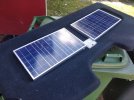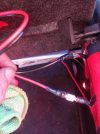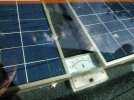Shortly after I bought my dashcam (see signature) I made this thread about various solutions (thanks to everyone that responded in that thread). TL;DR I settled on upgrading to a 60Ah AGM battery for my car and leaving it at that. With regular driving mid-week it gave full recording over the weekend and I was happy.
Then covid-19 happened and I wasn't driving much at all but still wanted my dashcam to be recording whilst parked. Photovoltaics to the rescue!
I bought 2x 10W solar panels from ebay costing £25 total. They came already wired with individual diodes to stop the battery discharging through the panels at night. I drilled some holes with a hole-saw in my parcel shelf and glued the panels down with tiger-seal. They are fused at 2A and wired into the car's electrics with spade connectors so I can still remove the parcel shelf easily. I have a distribution block for a small subwoofer amp and 1Farad powercap already in the boot/trunk so it was easy to wire the solar panels in.
I tried to use a cheap digital ammeter to measure the current they were supplying to the battery but for reasons I still don't quite understand I couldn't get it to work without a completely isolated supply (e.g. 9V battery) to power the ammeter itself. Trying to power the ammeter from the cars electrical system led to incorrect current readings. Maybe someone more skilled with electronics can explain exactly what's going on here and any solution?
My solution was was to ditch the digital voltmeter and go with a simple moving-coil analogue ammeter, £5 from ebay. Power-loss within the ammeter itself I've measured in the 'dozens of microwatts' range which is fine.
The photovoltaics charge at about 300-400mA when both in direct sunlight. When overcast they still charge at 20-50mA which is not bad.




Then covid-19 happened and I wasn't driving much at all but still wanted my dashcam to be recording whilst parked. Photovoltaics to the rescue!
I bought 2x 10W solar panels from ebay costing £25 total. They came already wired with individual diodes to stop the battery discharging through the panels at night. I drilled some holes with a hole-saw in my parcel shelf and glued the panels down with tiger-seal. They are fused at 2A and wired into the car's electrics with spade connectors so I can still remove the parcel shelf easily. I have a distribution block for a small subwoofer amp and 1Farad powercap already in the boot/trunk so it was easy to wire the solar panels in.
I tried to use a cheap digital ammeter to measure the current they were supplying to the battery but for reasons I still don't quite understand I couldn't get it to work without a completely isolated supply (e.g. 9V battery) to power the ammeter itself. Trying to power the ammeter from the cars electrical system led to incorrect current readings. Maybe someone more skilled with electronics can explain exactly what's going on here and any solution?
My solution was was to ditch the digital voltmeter and go with a simple moving-coil analogue ammeter, £5 from ebay. Power-loss within the ammeter itself I've measured in the 'dozens of microwatts' range which is fine.
The photovoltaics charge at about 300-400mA when both in direct sunlight. When overcast they still charge at 20-50mA which is not bad.




Last edited:


